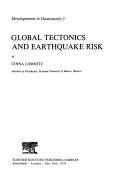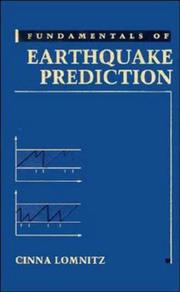| Listing 1 - 10 of 10 |
Sort by
|

ISBN: 0444410767 9781483289540 1483289540 1322264406 9780444410764 Year: 1974 Publisher: Amsterdam, New York, Elsevier Scientific Pub. Co.
Abstract | Keywords | Export | Availability | Bookmark
 Loading...
Loading...Choose an application
- Reference Manager
- EndNote
- RefWorks (Direct export to RefWorks)
Global Tectonics and Earthquake Risk
Geology. Earth sciences --- Earthquakes. --- Geodynamics. --- Quakes (Earthquakes) --- Earth movements --- Natural disasters --- Seismology --- Dynamic geology --- Tectonophysics --- Geophysics --- Géophysique --- Geophysics. --- Géodynamique. --- Séismes

ISBN: 0444410767 9781483289540 1483289540 Year: 1974 Publisher: Amsterdam Elsevier
Abstract | Keywords | Export | Availability | Bookmark
 Loading...
Loading...Choose an application
- Reference Manager
- EndNote
- RefWorks (Direct export to RefWorks)
Global Tectonics and Earthquake Risk.

ISBN: 0471574198 Year: 1994 Publisher: New York ; Chichester ; Singapore John Wiley & Sons
Abstract | Keywords | Export | Availability | Bookmark
 Loading...
Loading...Choose an application
- Reference Manager
- EndNote
- RefWorks (Direct export to RefWorks)
Book
ISBN: 0444414940 0444601449 9780444414946 9780444601445 Year: 1976 Volume: 15 Publisher: Amsterdam New York Elsevier Scientific Pub. Co. :Distributions for the United States and Canada, Elsevier/North Holland
Abstract | Keywords | Export | Availability | Bookmark
 Loading...
Loading...Choose an application
- Reference Manager
- EndNote
- RefWorks (Direct export to RefWorks)
Seismic Risk and Engineering Decisions
Earthquake engineering --- Génie parasismique --- 550.34 --- 624.042.7 --- Civil engineering --- Engineering --- Engineering geology --- Shear walls --- Seismology. Earthquakes --- Stress due to ground movements, earth tremors (earthquakes), seismic effects --- Earthquake engineering. --- 624.042.7 Stress due to ground movements, earth tremors (earthquakes), seismic effects --- 550.34 Seismology. Earthquakes --- Génie parasismique
Book
ISBN: 9400728093 9400728107 9786613574763 1280396849 Year: 2012 Publisher: Dordrecht [Netherlands] : Springer,
Abstract | Keywords | Export | Availability | Bookmark
 Loading...
Loading...Choose an application
- Reference Manager
- EndNote
- RefWorks (Direct export to RefWorks)
This book is an attempt to demonstrate the analytical power of the holistic approach for understanding disasters. Six major earthquakes in Latin America are used as an example: the general idea is to place disasters in a broad social and regional context. Understanding disasters is a way of understanding the social system. The idea is to show that every major disaster is unique and different. Statistical methods may be useful for purposes of risk estimation but modern disasters are "systemic" and complex. In the chapter on the 2010 Chile earthquake we discuss the tsunami and why the system of tsunami alert did not work. The introductory chapter contains some basics of seismology (plate tectonics) and earthquake engineering. The 1985 Mexico earthquake describes why geology is important. Why was Mexico City founded in a lake? Technology must be adapted to the environment, not "imported" from possibly more advanced but different societies. The 1970 Peru earthquake is an example of disaster in a unique environment. Caracas 1967 takes us on a survey of different engineering solutions. And the 1960 Chile earthquake leads us on a retrospective survey--what has changed in Chile between the two major Chile earthquakes? A discussion on Charles Darwin’s observations of the 1835 Chile earthquake provides a fitting summary.
Earthquake damage -- Latin America. --- Earthquakes -- Latin America. --- Seismology -- Research -- Latin America. --- Earthquakes --- Seismology --- Earthquake damage --- Social Welfare & Social Work --- Geography --- Geology --- Earth & Environmental Sciences --- Social Sciences --- Physical Geography --- Social Welfare & Social Work - General --- Dynamic & Structural Geology --- Social aspects --- Research --- Natural disasters --- History. --- Natural calamities --- Quakes (Earthquakes) --- Earth sciences. --- Geophysics. --- Natural disasters. --- Social sciences. --- Earth Sciences. --- Natural Hazards. --- Geophysics/Geodesy. --- Social Sciences, general. --- Geological physics --- Terrestrial physics --- Earth sciences --- Physics --- Geosciences --- Environmental sciences --- Physical sciences --- Behavioral sciences --- Human sciences --- Sciences, Social --- Social science --- Social studies --- Civilization --- Disasters --- Earth movements --- Geology. --- Physical geography. --- Geognosy --- Geoscience --- Natural history
Digital
ISBN: 9789400728103 Year: 2012 Publisher: Dordrecht Springer Netherlands
Abstract | Keywords | Export | Availability | Bookmark
 Loading...
Loading...Choose an application
- Reference Manager
- EndNote
- RefWorks (Direct export to RefWorks)
Social sciences (general) --- Geophysics --- Meteorology. Climatology --- Geology. Earth sciences --- Physical geography --- aardbevingen --- sociale wetenschappen --- geologie --- fysische geografie --- geofysica --- natuurrampen --- Latin America
Digital
ISBN: 9780444414946 0444414940 9780444601445 0444601449 Year: 1976 Publisher: New York Distributions for the United States and Canada, Elsevier/North Holland
Abstract | Keywords | Export | Availability | Bookmark
 Loading...
Loading...Choose an application
- Reference Manager
- EndNote
- RefWorks (Direct export to RefWorks)
Book
Year: 1976 Publisher: Amsterdam : Elsevier Scientific Publishing Company,
Abstract | Keywords | Export | Availability | Bookmark
 Loading...
Loading...Choose an application
- Reference Manager
- EndNote
- RefWorks (Direct export to RefWorks)
Earthquake engineering. --- Génie parasismique --- Tsunamis. --- Tsunamis --- Seismology. --- Sismologie.
Book
ISBN: 9789400728103 Year: 2012 Publisher: Dordrecht Springer Netherlands
Abstract | Keywords | Export | Availability | Bookmark
 Loading...
Loading...Choose an application
- Reference Manager
- EndNote
- RefWorks (Direct export to RefWorks)
This book is an attempt to demonstrate the analytical power of the holistic approach for understanding disasters. Six major earthquakes in Latin America are used as an example: the general idea is to place disasters in a broad social and regional context. Understanding disasters is a way of understanding the social system. The idea is to show that every major disaster is unique and different. Statistical methods may be useful for purposes of risk estimation but modern disasters are "systemic" and complex. In the chapter on the 2010 Chile earthquake we discuss the tsunami and why the system of tsunami alert did not work. The introductory chapter contains some basics of seismology (plate tectonics) and earthquake engineering. The 1985 Mexico earthquake describes why geology is important. Why was Mexico City founded in a lake? Technology must be adapted to the environment, not "imported" from possibly more advanced but different societies. The 1970 Peru earthquake is an example of disaster in a unique environment. Caracas 1967 takes us on a survey of different engineering solutions. And the 1960 Chile earthquake leads us on a retrospective survey--what has changed in Chile between the two major Chile earthquakes? A discussion on Charles Darwin's observations of the 1835 Chile earthquake provides a fitting summary.
Social sciences (general) --- Geophysics --- Meteorology. Climatology --- Geology. Earth sciences --- Physical geography --- aardbevingen --- sociale wetenschappen --- geologie --- fysische geografie --- geofysica --- natuurrampen --- Latin America
Book
ISBN: 012456450X Year: 1977 Publisher: New York (N.Y.) Academic press
Abstract | Keywords | Export | Availability | Bookmark
 Loading...
Loading...Choose an application
- Reference Manager
- EndNote
- RefWorks (Direct export to RefWorks)
Rural-urban migration --- Squatter settlements --- Mexico City (Mexico) --- Social conditions.
| Listing 1 - 10 of 10 |
Sort by
|

 Search
Search Feedback
Feedback About UniCat
About UniCat  Help
Help News
News